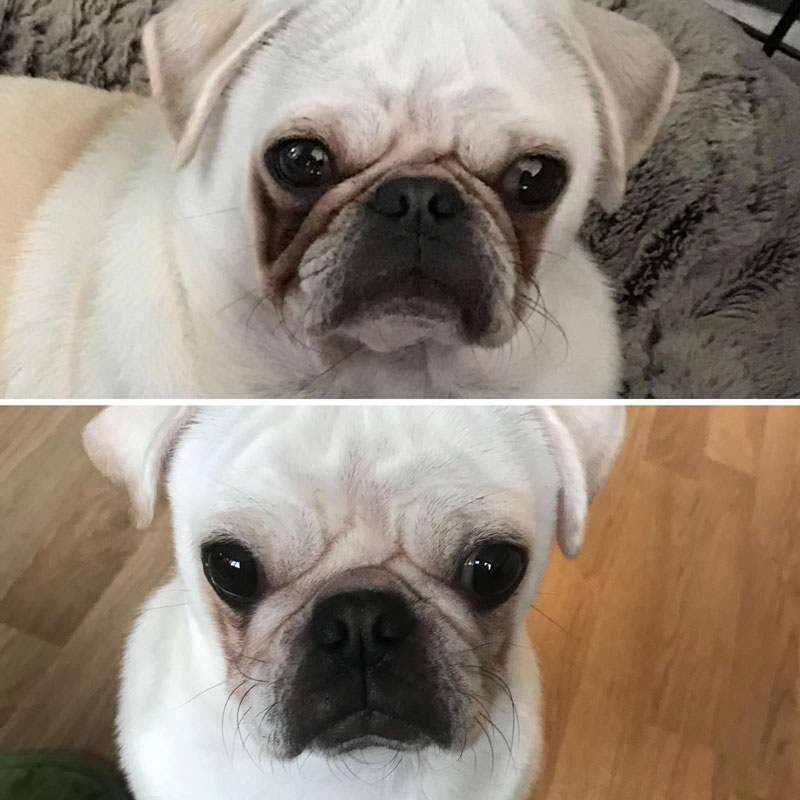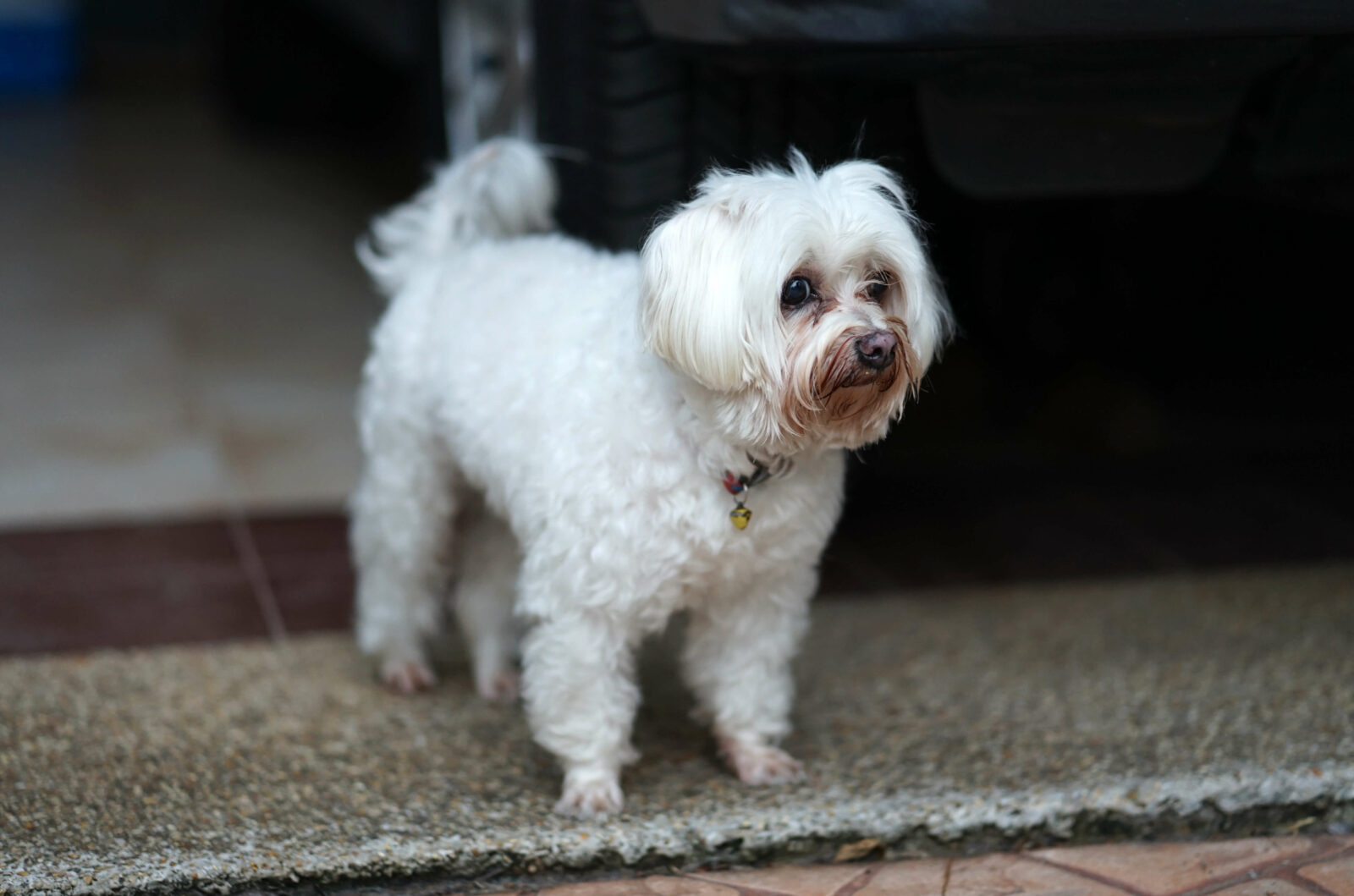Blog, General dog nutrition
Dogs and fur staining
Updated July 2023 by Kristina Johansen Cert. ACN
Most people who own a dog, particularly one with white fur, will be familiar with the issue of fur staining. Patches of fur in certain areas of the body turning red or brown and growing darker in colour over time.
Thankfully, this discolouration itself doesn’t cause your dog any harm – it’s merely a cosmetic issue. However, fur stains can be a symptom of an underlying health conditions.
Once you understand how fur stains on dogs develop, you’ll be better equipped to remove and prevent them in the future.
The chemistry of it all
At the chemical level, red-brown fur staining is caused by a compound called porphyrin. Porphyrins are iron containing molecules produced when the body breaks down red blood cells. They are removed from the body primarily through faeces.
However, porphyrin can also be excreted through tears, saliva, and urine. All dogs produce and excrete porphyrins, but porphyrin staining is of course more noticeable in dogs with white fur.
Causes of fur staining
There are a number of different factors that can contribute to your dog’s fur becoming stained.
Young puppies produce more tears when they are teething, but this should decrease once they reach maturity. In adult dogs, contributing factors can be broken down into three categories – medical conditions, allergies and breed.
1. Medical Conditions
Eye staining
Medical issues that can lead to staining around the eyes include eye irritation, blocked tear ducts, eye infections (bacterial, viral or fungal) and trauma to the eye (e.g. a scratch or cut). Poor grooming, resulting in a lot of hair around the eye can also stimulate excess production of tears, and can give yeast infections an environment in which to thrive and grow.
Anatomical or conformational abnormalities that can lead to stained eye fur include: overactive tear ducts, narrow tear ducts, narrow eyes, shallow eye sockets, extra skin folds, abnormally placed eyelashes and rolling of the eyelids.
Mouth staining
Medical issues such as gum disease, excess saliva production and dental problems including abscesses can result in dogs producing large amounts of saliva. In a lot of cases, the excess saliva is produced as a way to try and get rid of excess bacteria that is present as a result of dental / periodontal problems.
These issues can also result in your dog having difficultly chewing their food, which in turn can cause excess saliva to produced, be unevenly distributed around the mouth and to trickle down the sides of the mouth.
2. Allergies
As with people, dogs have allergies to things like pollen, certain foods, certain plants etc. And as with people, dog’s will do everything they can to relieve the irritation and discomfort caused by these allergies.
By and large, the way dogs do this is to lick the affect area. This means they are depositing a lot of saliva on different areas of fur around their body. Saliva which if not cleaned up and left to accumulate can result in staining.
Licking to relieve allergy symptoms also makes the fur quite damp, and scratching to relieve it can result in damage to the skin. Both of these can lead to areas of fur that act as a rich, fertile breeding ground for yeast infections that can result in brown fur staining.
If your dog’s stains appear in the spring, it’s likely that your dog suffers from seasonal allergies. However, if tear stains are a year-round problem, it’s more likely linked to food intolerances.
In addition, allergens can also cause irritation and inflammation to the eyes, which results in production of more tears and so can lead to staining around the eye area.
3. Breed
Certain dog breeds like Pugs, Poodles, Maltese, Boxers, Bichons, and Bulldogs are more susceptible to fur staining due to features like short noses, a flat face, congenital tear duct abnormalities and large eyes.
How to treat fur staining
Before trying to remove your dogs stains, it’s important that your vet rule out out any medical causes. You don’t want to unknowingly allow a serious problem to worsen. Once that’s confirmed, there are several proactive steps you can take to both prevent and clean your dogs fur:
- Keep regular appointments with your groomer to ensure that the hair around your dog’s eyes doesn’t grow too long and cause irritation.
- Clean the fur and face twice daily with a damp cloth to remove excess saliva and tears.
- To lighten existing stains, you can use a contact lens cleaner with boric acid to clean the area around (not on) your dog’s eyes.
- Always feed from a stainless steel or ceramic food bowl. Plastic is easily scratched and can harbour bacteria which can cause facial irritation.
- For dogs with suspected food allergies, a high-quality, novel diet is vital
There are several over-the-counter eye wipes as well as supplements that claim to reduce the amount of porphyrin in the tears. The effects of these are questionable, and it’s important that you speak with your vet before putting any new solution in your dog’s eyes or give them supplements.
Diet and fur staining
Choosing the right diet can significantly change things for most dogs.
Initially, an elimination diet can work wonders. You’ll need to play detective for a while, methodically introducing new foods to determine what suits your dog’s unique dietary needs the best. For more information on elimination diets, you can learn more via this link:
Elimination diets for dogs: what, when and how
It’s important to be conscious of, not only the food your dog eats, but also any supplements you are giving. It’s easy to overlook these as potential triggers, but they too can cause a reaction.
Alternatively, a switch from commercial dog food to a simple homemade diet might also bring significant improvements. It’s all about taking control and knowing exactly what your dog eats.
Here’s a gorgeous little boy I worked with a while back, before and just a few weeks after diet change. Big improvement!

I hope the information in this blog has been helpful. If you have any questions or suggestions on how I can improve the blog, please email me at kristina@elmoskitchen.com

